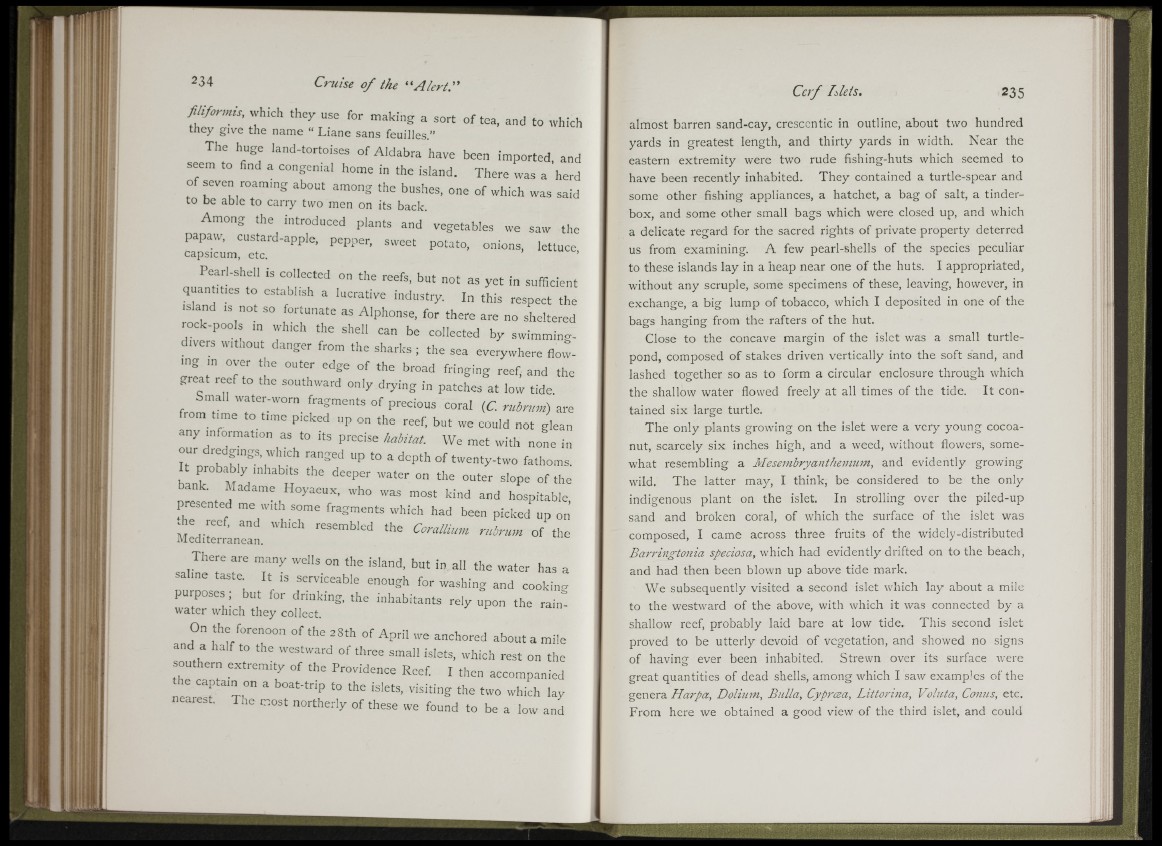
*
,p
' ! iì
m o n u is . which they use for making a sort of tea, and to which
they give the name “ Liane sans feuilles.”
The huge land-tortoises of Aldabra have been imported, and
seem to find a congenial home in the island. There was a herd
of seven roaming about among the bushes, one of which was said
to be able to carry two men on its back.
Among the introduced plants and vegetables wc saw the
papaw. custard-apple, pepper, sweet potato, onions, lettuce
capsicum, etc. ’
Pearl-shell is collected on the reefs, but not as yet in sufficient
quantities to establish a lucrative industry. In this respect the
island IS not so fortunate as Alphonse, for there are no sheltered
rock-pools m which the shell can be collected by swimmingdivers
w.tnout danger from the sharks ; the sea everywhere f lo i t
mg m over the outer edge of the broad fringing reef, and the
,reat reef to tlie soutliward only drying in patclies at low tide
Small water-worn fragments of precious coral (C. r.^brum) are
from time to tune picked up on the reef, but we could not glean
any information as to its precise habUat. We met with none in
our diedgings, which ranged up to a depth of twenty-two fathoms.
It probably inliabits the deeper water on the outer slope of the
bank. Madame Hoyaeux, who was most kind and hospitable
presented me with some fragments which had been picked up on’
-he reef, and which resembled the ara//,um rubnm of the
xAlediterrancan.
There are many wells on the island, but in all the water has a
saline taste^ It ,s serviceable enough for washing and eooki.,.r
purposes ; but for drinking, the inliabitants rely upon the rain-
water which they collect.
On the forenoon of the 38th of April we anchored about a mile
nd a half to the westward of three small islets, which rest on the
southern extremity of the Providence Reef. I then accompanied
captain on a boat-trip to the islets, visiting the two which lay
nearest. The most northerly of these we found to be a low and
Cerf Llets. 235
almost barren sand-cay, crcsccntic in outline, about two hundred
yards in greatest length, and thirty yards in width. Near the
eastern extremity were two rude fishing-huts which seemed to
have been recently inhabited. They contained a turtle-spear and
some other fishing appliances, a hatchet, a bag of salt, a tinder-
box, and some other small bags which were closed up, and which
a delicate regard for the sacred rights of private property deterred
us from examining. A few pearl-shells of the species peculiar
to these islands lay in a heap near one of the huts. I appropriated,
without any scruple, some specimens of these, leaving, however, in
exchange, a big lump of tobacco, which I deposited in one of the
bags hanging from the rafters of the hut.
Close to the concave margin of the islet was a small turtle-
pond, composed of stakes driven vertically into the soft sand, and
lashed together so as to form a circular enclosure through which
the shallow water flowed freely at all times of the tide. It contained
six large turtle.
The only plants growing on the islet were a very young cocoa-
nut, scarcely six inches high, and a weed, without flowers, somewhat
resembling a Mesembryanthemum, and evidently growing
wild. The latter may, I think, be considered to be the only
indigenous plant on the islet. In strolling over the piled-up
sand and broken coral, of which the surface of the islet was
composed, I came across three fruits of the widely-distributed
Barringtonia speciosa, which had evidently drifted on to the beach,
and had then been blown up above tide mark.
We subsequently visited a second islet which lay about a mile
to the westward of the above, with which it was connected by a
shallow reef, probably laid bare at low tide. This second islet
proved to be utterly devoid of vegetation, and showed no signs
of having ever been inhabited. Strewn over its surface were
great quantities of dead shells, among which I saw examp’cs of the
genera Harpa, Dolium, Bulla, Cyproea, Littorina, Voluta, Conns, etc.
From here we obtained a good view of the third islet, and could